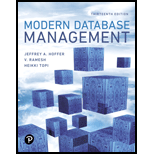
Concept explainers
Definitions of the following terms:
a. Application partitioning
b. Application
c. Client/server system
d. Middleware
e. Three-tier architecture
f. locking
g. versioning
h. deadlock
Explanation of Solution
Application partitioning
The method of assigning components of application software, after it is written, to client or server partitions in order to gain increased performance and interoperability is termed as application partitioning. Here, interoperability refers to ability to function on different platforms.
Application programming interface (API)
An API is a set of routines, protocols and tools that are used by an application program to interact with other software applications. APIs are used for software development and in context to
Client/server system
It is a networked computing model in which processes are distributed between clients and servers, which provide the needed services. Generally heavy processing applications are stored on the server and light application reside on a client. Client continuously interacts with the server to perform certain tasks. In context of a database system, the database along with the DBMS generally resides on a server and server is responsible for processing the DBMS. End user application system resides on the client which requests services from the client.
Middleware
Middlewares are softwares which act as a bridge between application and
Three-tier architecture
It is a three-layer client/server configuration where one client layer and two server layers are present. This architecture contains one additional server layer as compared to two-tier client/server architecture.
Locking
It is a
Versioning
It is an approach for concurrency control during which each transaction under execution is limited to a portion of the database during its execution period, and when a transaction tries to modify a record, new record version for it is created instead of overwriting the old record.
Deadlock
It is a situation in which no progress can be made during transaction processing. It occurs when two or more transactions have acquired some common limited resources.
Want to see more full solutions like this?
Chapter 7 Solutions
Modern Database Management
- How does application virtualization work, and what are its use cases?arrow_forwardExplain the concept of virtualization in the context of Windows Server. What virtualization technologies are available, and how do they impact server management?arrow_forwardWhat is the role of application virtualization, and how does it differ from server virtualization?arrow_forward
- It's important to establish what exactly is meant by "application virtualization."arrow_forwardExplain the architecture of Windows Active Directory and its use in managing network resources and user authentication in a corporate environment.arrow_forwardVirtualization will affect two operating systems.arrow_forward
- Describe what virtualisation is and describe the characteristic attributes of the different types of virtualisation (Language, Operating System and Hardware).arrow_forwardDescribe the components and features of Windows Hyper-V for virtualization and resource management.arrow_forwardIdentify two operating system effects of virtualization.arrow_forward
 Systems ArchitectureComputer ScienceISBN:9781305080195Author:Stephen D. BurdPublisher:Cengage Learning
Systems ArchitectureComputer ScienceISBN:9781305080195Author:Stephen D. BurdPublisher:Cengage Learning
